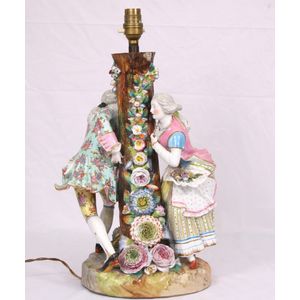Meissen porcelain was first produced in the town of Meissen, Germany, in the early 18th century. It is widely regarded as one of the finest examples of European porcelain and has a long and fascinating history.
The story of Meissen porcelain begins in 1708, when the ruler of Saxony, Augustus the Strong, ordered the establishment of a porcelain factory in the town of Meissen. The factory was founded by a group of artisans led by Johann Friedrich Bottger, who had been searching for a way to make true porcelain for many years while trying to make heat resistant crucibles for
more...
goldmaking. Bottger had been imprisoned by Augustus for failing to deliver on a promise to produce gold from base metals. He was eventually released and put to work on the gold project.
For nearly six years, Böttger experimented desperately. Although unable to produce gold, he did manage to make another important breakthrough-the recipe for "true" or hard-paste porcelain that was of exceptional quality. Meissen porcelain quickly became very popular among the wealthy and powerful, and the factory grew rapidly.
Over the years, Meissen porcelain became known for its distinctive style, which featured intricate designs, delicate shapes, and bright colours. The factory also pioneered many new techniques and processes for making porcelain, including the use of moulds, the production of figurines, and the development of a wide range of glazes.
During the 18th and 19th centuries, Meissen porcelain became one of the most important luxury goods produced in Europe, and the factory was widely regarded as the leader in the field. Meissen porcelain was used to create everything from tableware and decorative objects to large-scale sculptures and architectural elements.
Meissen porcelain remains highly sought after by collectors and connoisseurs of fine art and design. The porcelain is still produced using traditional techniques and materials, and many of the classic designs from the past continue to be popular today.
less...
Kerosene lamps from the 19th century represent a significant development in lighting technology and played a crucial role in illuminating homes, businesses, and streets during that era. Kerosene is also known as liquid paraffin.
Prior to the introduction of kerosene lamps, lighting options were limited to candles, oil lamps, or gas lamps. Candles were the most common source of light, but they were expensive, produced limited illumination, and posed a significant fire hazard. Oil lamps, fueled by various vegetable oils, were an improvement over candles, but they were still prone to smoke, odor, and the risk of fire. The arrival
more...
of kerosene lamps in the mid-19th century marked a turning point in lighting technology.
Kerosene, a flammable hydrocarbon liquid derived from petroleum, became a popular fuel for lamps due to its clean-burning properties and relatively low cost. Kerosene lamps were more efficient and produced a brighter, steadier light compared to previous oil lamps. The introduction of kerosene lamps also coincided with advancements in lamp design, with manufacturers producing a wide range of styles and sizes to suit different needs and preferences.
The design of 19th-century kerosene lamps varied, but they typically consisted of a reservoir for holding the kerosene, a burner, and a chimney to direct the light and protect the flame. The reservoir could be made of glass, metal, or ceramic, and it often featured ornate decorations or patterns to enhance the lamp's aesthetic appeal. The burner incorporated a wick that drew kerosene from the reservoir and allowed it to burn, while the chimney helped to stabilize the flame and reduce the risk of accidents.
The introduction of kerosene lamps had a transformative effect on society. They brought illumination to areas that were previously in darkness, making it easier and safer to perform tasks, study, and socialize after sunset. The availability of affordable and reliable lighting had a profound impact on productivity, allowing people to extend their working hours and engage in various activities during the evenings.
Kerosene lamps were widely used in both urban and rural areas throughout the 19th century. They were particularly beneficial in areas without access to gas lighting or electricity, and they remained popular even after the introduction of electric lighting in the late 19th century. Kerosene lamps were commonly found in homes, businesses, and public spaces, including streets and outdoor areas.
However, the use of kerosene lamps was not without its drawbacks. The lamps required regular maintenance, including cleaning the wicks, replenishing the fuel, and ensuring proper ventilation to prevent the accumulation of fumes. Accidents, such as lamp explosions or fires, were also a risk if the lamps were mishandled or not properly maintained.
less...





 Loading more...
Loading more...